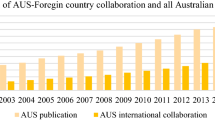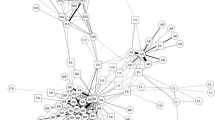Abstract
The objective of this study is to investigate scientific collaboration in biotechnology in the northeast region of Brazil. The data presented refer to the 1980–2010 period and were collected from the Brazilian National Council for Scientific and Technological Development platform database known as Lattes (a compilation of curricula vitae of researchers in Brazil, including a record of their scientific production) and from the Institute for Scientific Information Web of Science database. Our analysis involved the use of bibliometric indicators, specifically co-authorship between or among institutions, as well as the evaluation of social networks and multivariate statistics. Overall, we verified that collaboration takes place mostly at the intra-institutional level. At intra-regional scale, we could observe the development of four clusters in relation to the collaboration dynamics, in which geographic proximity stands out as grouping factor. At the interregional level, the partnerships revolve around institutions that count with laboratory infrastructure and research tradition in the field of biotechnology. Regarding international collaboration, it remains connected to national scientific cooperation programs.




Similar content being viewed by others
Notes
The residence of the authors and co-authors constitute the point of reference and are studied as networks of links among those who have worked in conjunction for the development and creation of knowledge.
A researcher has access to the collaboration network by entering his/her name in the Lattes platform. (http://lattes.cnpq.br/) and then choosing to enter the collaboration network. This network shows the researchers who collaborated with the professor/researcher as co-authors of scientific papers.
To construct MDS and cluster analysis, we followed three steps: The first consisted in turning the collaboration matrix into a similarity matrix using Pearson’s correlation coefficient. The second was the construction of the Proxscal MDS model using the Euclidean distance algorithm. The third consisted in generating the dendrogram as a result of the cluster analysis (Average Linkage—Between Groups method, using the Euclidean distance algorithm). The data were processed on SPSS, version 19.
Science, technology, and innovation in the northeast, specifically in the field of biotechnology, is developed within the context of the semi-arid climate. Biotechnology holds the promise of resolving major problems, as well as showing potential in terms of the effective use of the biodiversity of the region (Brasil, 2010).
Launched in July of 2011, the program has the objectives of advancing science, technology, innovation, and industrial competitiveness through the expansion of international mobility; increasing the presence of student and researchers from Brazil in institutions of excellence abroad; promoting greater internationalization of Brazilian universities; increasing innovative knowledge among the workforce of Brazilian industry; and attracting young talent and highly qualified researchers to work in Brazil.
Company involved in the genetic development of plants related to agribusiness. Headquartered in the city of Campinas, the company has seven technology parks, two of which are in the northeast (in the cities of Maceió and São Raimundo das Mangabeiras). Source: http://pt.wikipedia.org/wiki/CanaVialis.
Petrobrás is a consolidated energy company, with an international profile, as well as being a world leader in deep-water oil exploration. Northeast Brazil has Petrobrás refineries that produce liquefied petroleum gas, diesel fuel, aviation kerosene, gasoline and naphtha.
References
Arboit, A. E., Bufrem, L. S., & Moreiro González, J. A. (2011). A produção brasileira em Ciência da Informação no exterior como reflexo de institucionalização científica. Perspectivas em Ciência da Informação, 16(3), 75–92.
Arunachalam, S., & Doss, M. J. (2000). The effect of postings information on searching behavior Science in a small country at a time of globalisation: domestic and international collaboration in new biology research in Israel. Journal of Information Science, 26(1), 39–49.
Aucélio, J. G., & Sant’Ana, P. J. P. (2006). Trinta anos de políticas públicas no Brasil para a área de biotecnologia. Parcerias Estratégicas, 10(23), 251–268.
Barabási, A. L., Jeong, H., Néda, Z., Ravasz, E., & Schubert, A. (2002). Evolution of the social network of scientific collaborations. Physica A, 311(3–4), 590–614.
Barbosa, P.J. (1990). Grupos de pesquisadores da área de química do Nordeste: origens, desempenho e perspectivas. http://www.bibliotecadigital.unicamp.br/document/?code=vtls000026925. Retrieved 12 Nov 2011.
Borgatti, S. P. (2002). Netdraw network visualization. Harvard, MA: Analytic Technologies.
Borgatti, S. P., Everett, M. G., & Freeman, L. C. (2002). Ucinet for Windows: Software for Social Network Analysis. Harvard, MA: Analytic Technologies.
Brasil. (2002). Programa de Biotecnologia e recursos genéticos: definição de metas. Brasília: MCT.
Brasil (2007). Decreto nº 6.041 de 8 de fevereiro de 2007. Institui a política de Desenvolvimento em Biotecnologia, cria o Comitê Nacional de Biotecnologia e dá outras providências. Diário Oficial da União. Brasília.
Brasil. (2010). Edital CT-HIDRO/AÇÃO TRANSVERSAL-LEI/MCT/CNPq Nº 07/2010. http://www.cnpq.br/editais/ct/2010/007.htm. Retrieved 12 Jan 2012.
Capes. 2011. Cursos recomendados. http://capes.gov.br/cursos-recomendados. Retrieved 18 Sep 2011.
Carpenter, M., Baver, T., & Erdogan, B. (2009). Social network. In M. Carpenter, T. Baver, & B. Erdogan (Eds.), Principles of Management: A Behavioral Approach. New York: Flat World Knowledge.
CGEE. (2008). Brasil: A Economia Natural do Conhecimento. Brasília: CGEE.
Costa, B. M. G., Pedro, E. da S., & Macedo, G. R. (2010). Academic patents in biotechnology in the Northeast Region of Brazil. Proceedings of the 3º Congresso Brasileiro de Biotecnologia (pp. 152–153). Renorbio: Fortaleza.
Dalpé, R. (2002). Bibliometrics analysis of Biotechnology. Scientometrics, 55(2), 189–213.
Everett, M., & Borgatti, S. P. (2005). Ego network betweenness. Social Networks, 27(1), 31–38.
Figueiredo, D.R. (2011). Redes complexas—Aula 3. http://www.land.ufrj.br/~daniel/rc/slides/aula_3.pdf. Retrieved 20 Aug 2011.
Freeman, L. C. (2005). Graphic Techniques for Exploring Social Network Data. In P. J. Carrington, J. Scott, & S. Wasserman (Eds.), Models and Methods in Social Networks Analysis. New York: Cambridge University Press.
Frenken, K., Hölzl, W., & Vor, F. (2005). The citation impact of research collaborations: the case of European biotechnology e applied microbiology (1998–2002). Journal of Engineering Management and Technology, 22(1–2), 9–30.
Frenken, K., & Van Oort, F. G. (2004). The geography of research collaboration: theoretical considerations and stylised facts in biotechnology in Europe and the United States. In P. Cooke & A. Piccaluga (Eds.), Regional Economies as Knowledge Laboratories (pp. 38–57). Cheltenham UK and Northampton MA: Edward Elgar.
Gaulthier, E. (1998). Bibliometric analysis of scientific and technological research: A user’s guide to the methodology. http://publications.gc.ca/collections/Collection/Statcan/88F0006X/88F0006XIE1998008.pdf. Retrieved 12 Aug 2011.
Gay, B., & Dousset, B. (2005). Innovation and network structural dynamics: study of the alliance network of a major sector of the biotechnology industry. Research Policy, 34(10), 1457–1475.
Glanzel, W., & Zhow, P. (2011). Publication activity, citation impact and bi-directional links between publications and patents in biotechnology. Scientometrics, 86(2), 505–525.
Hair, J. F, Jr, Anderson, R. E., Tatham, R. L., & Black, W. C. (2005). Análise multivariada de dados. Porto Alegre: Bookman.
Huisman, M., & van Duijin, M. A. J. (2005). Softwares for Social Network Analysis. In P. J. Carrington, J. Scott, & S. Wasseman (Eds.), Models and Methods in Social Networks Analysis (pp. 270–316). New York: Cambridge University Press.
IBGE (2010). Censo demográfico 2010: primeiros resultados. http://www.ibge.gov.br/home/estatistica/populacao/censo2010/default.shtm. Retrieved 10 Feb 2012.
Leta, J., Glanzel, W., & Thijs, B. (2006). Science in Brazil. Part 2: sectoral and institutional research profiles. Scientometrics, 67(1), 87–105.
Leta, J., Pereira, J. C. R., & Chaimovich, H. (2005). The Life Sciences - the relative contribution of the University of São Paulo to the highest impact factor journals and to those with the largest number of articles, 1980 to 1999. Scientometrics, 63(3), 599–616.
Lima, R. R., Velho, L. M. L. S., & Faria, L. I. L. (2007). Indicadores bibliométricos de cooperação científica internacional em bioprospecção. Perspectivas em Ciência da Informação, 12(1), 50–64.
Luukkonen, T., Persson, O., & Sivertsen, G. (1992). Understanding patterns of Internacional Scientific Collaboration. Science, Technology and Human Values, 17(1), 101–126.
Miguel, S., Moya-Anegon, F., & Herrero-Solana, V. (2008). A new approach to institutional domain analysis: multilevel research fronts structure. Scientometrics, 74(3), 331–334.
Moody, J. (2004). The structure of a Social Science Collaboration network: disciplinary cohesion from 1963 to 1999. American Sociological Review, 69(2), 213–238.
Moura, A. M. M. (2009). A interação entre Artigos e Patentes: um estudo cientométrico da comunição científica e tecnológica em Biotecnologia. http://www.lume.ufrgs.br/handle/10183/1856. Retrieved 18 Sep 2011.
Newman, M. E. J. (2001a). The structure of scientific collaboration networks. Proceedings of the National Academic Sciences, 98(2), 404–409.
Newman, M. E. J. (2001b). Scientific collaboration networks I. Network construction and fundamental results. Physical Review E, 64(016131), 1–8.
Newman, M. E. J. (2004). Co-authorship networks and patterns of scientific collaboration. Proceedings of the National Academic Sciences, 10(no.Suppl 1), 5200–5205.
OCDE. National Innovation Systems. (1997). http://www.oecd.org/dataoecd/35/56/2101733.pdf. Retrieved 10 Jun 2011.
Okubo, Y. (1997). “Bibliometric Indicators and Analysis of Research Systems: Methods and Examples”, OECD Science, Technology and Industry Working Papers, 1997/01, OECD. http://dx.doi.org/10.1787/208277770603. Retrieved 20 Nov 2011.
Oliver, A. L. (2004). Biotechnology entrepreneurial scientist and their collaborations. Research Policy, 33(4), 583–597.
Onodera, N. A. (2011). Method for elimination articles by homonymous authors from the large number of article retrieved by author search. Journal of the American Society and Technology, 62(4), 677–690.
Otte, E., & Rosseau, R. (2002). Social network analysis a powerful strategy, also for the information sciences. Journal of Information Science, 28(6), 441–453.
Packer, A. L. (2011). Os periódicos brasileiros e a comunicação da pesquisa nacional. Rev USP, 89, 26–61.
Palis Júnior, J. (2010). Um olhar sobre a ciência brasileira e sua presença internacional. Parcerias Estratégicas, 15(31), 73–102.
Pedro, E. da S. (2008) Estratégias para a organização da pesquisa em cana-de-açúcar : uma análise de governança em sistemas de inovação. http://www.bibliotecadigital.unicamp.br/document/?code=000432820. Retrieved 30 Aug 2012.
Pena, S. D. J. (2010). O estado da ciência no Brasil: como dar um salto de qualidade. Parcerias Estratégicas, 15(31), 115–128.
Peters, L., Groenewegen, P., & Fiebelkorn, N. (1998). A comparison of networks between industry and public sector research in materials technology and biotechnology. Research Policy, 27(3), 255–271.
Powell, W. W., Koput, K. W., & Smitt-Doer, L. (1996). Interorganizational collaboration and the locus of innovation: networks of learning in Biotechnology. Administrative Science Quarterly, 41(1), 116–145.
Sandstrom, A., Petterson, I., & Nilsson, A. (2000). Knowledge production and knowledge flows in the Swedish biotechnology innovation system. Scientometrics, 48(2), 179–201.
Valle, M. G. (2005). O Sistema Nacional de Inovação em Biotecnologia no Brasil: Possíveis Cenários. http://www.bibliotecadigital.unicamp.br/document/?code=vtls000375779&fd=y. Retrieved 12 Nov 2010.
Vanz, S. A. S. (2010). As redes de colaboração científica no Brasil (2004−2006). http://www.lume.ufrgs.br/handle/10183/17169. Retrieved 18 Aug 2012.
Velho, L., & Souza-Paula, M.C. (2008). Avaliação de políticas de ciência e tecnologia e inovação: Diálogo entre experiências internacionais e brasileira. Brasília: CGEE.
Wagner, C. S., & Leydesdorff, L. (2005). Network structure, self-organization, and the growth of international collaboration in science. Research Policy, 34(10), 1608–1618.
Author information
Authors and Affiliations
Corresponding author
Rights and permissions
About this article
Cite this article
Costa, B.M.G., da Silva Pedro, E. & de Macedo, G.R. Scientific collaboration in biotechnology: the case of the northeast region in Brazil. Scientometrics 95, 571–592 (2013). https://doi.org/10.1007/s11192-012-0924-1
Received:
Published:
Issue Date:
DOI: https://doi.org/10.1007/s11192-012-0924-1




